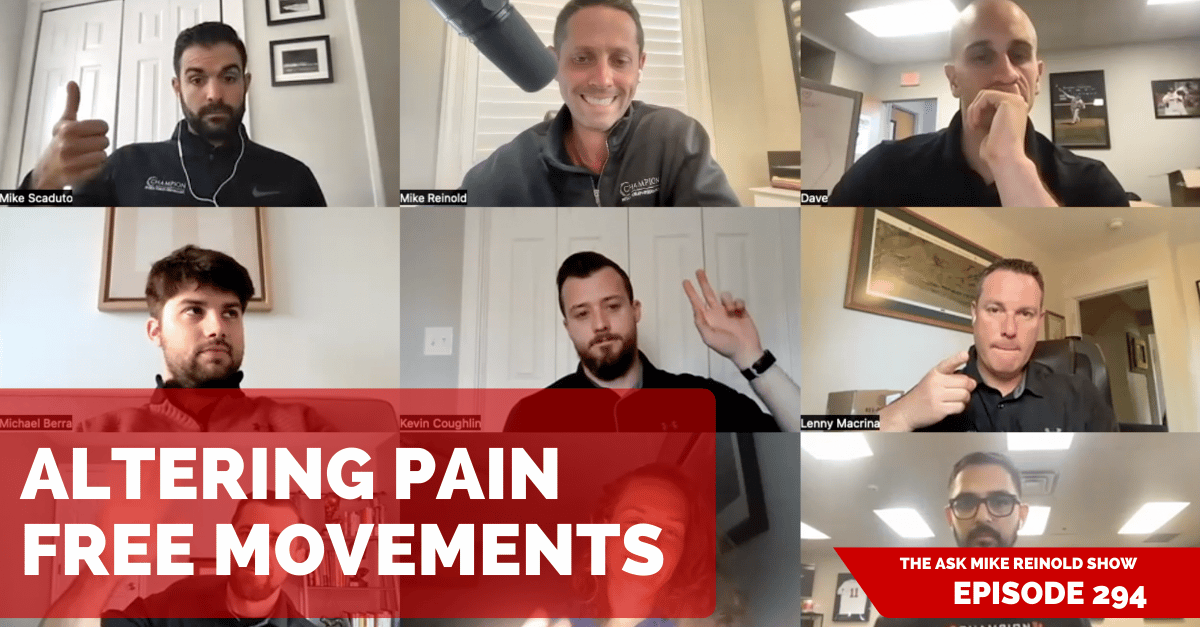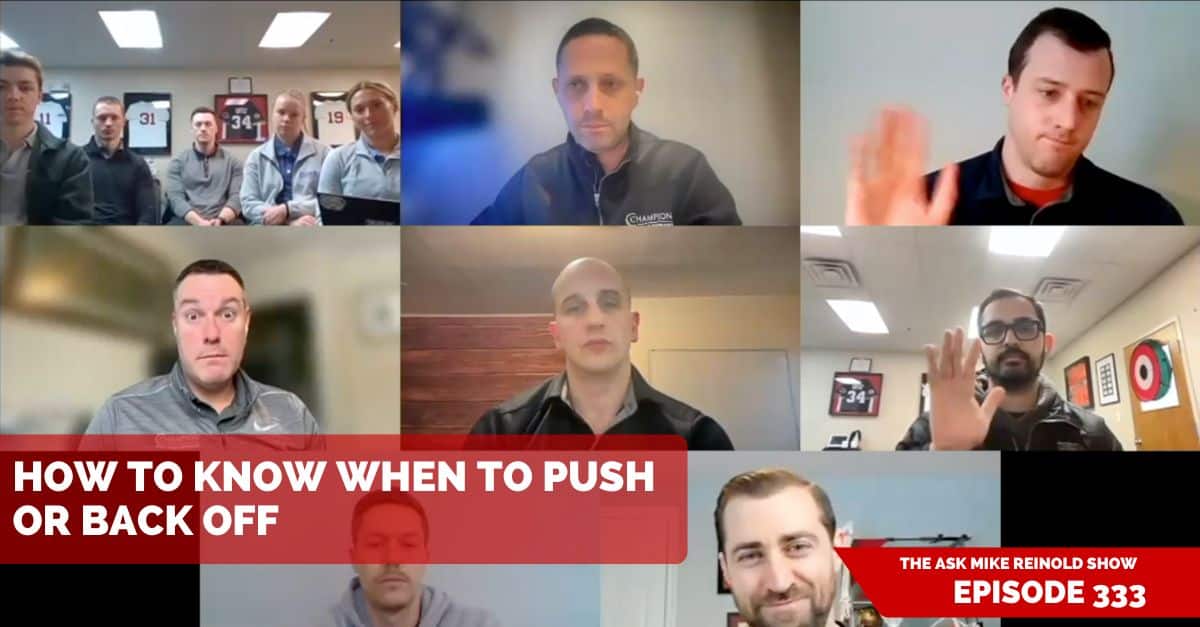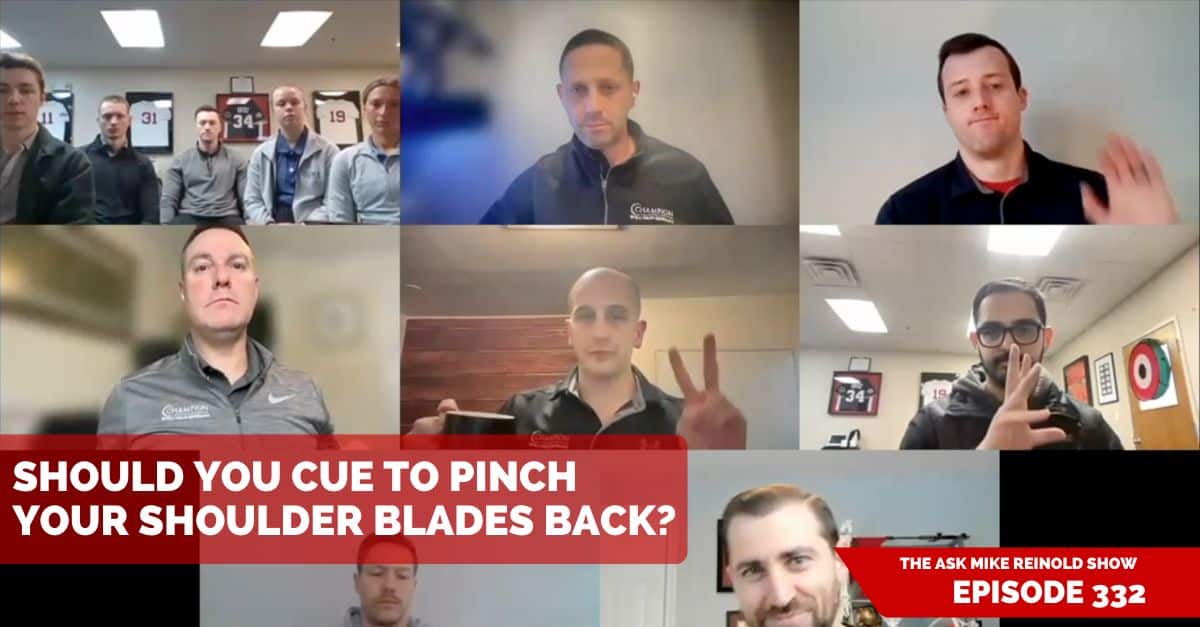A common theme right now is “there is no such thing as good or bad” movements.
I agree with this, to an extent, but certainly not all the time.
Many people still recommend identifying poor movements and trying to correct them. But what do you do when someone moves poorly but has no pain with the movement?
To view more episodes, subscribe, and ask your questions, go to mikereinold.com/askmikereinold.
#AskMikeReinold Episode 294: Altering Pain Free Movements
Listen and Subscribe to Podcast
You can use the player below to listen to the podcast or subscribe. If you are enjoying the podcast, PLEASE click here to leave us a review in iTunes, it will really mean a lot to us. THANKS!
Show Notes
Transcript
Student – Michael Berra:
Today we got a question about altering pain-free movements. So from Kevin in New York City, he’s asking, “When would you change someone’s pain-free movement pattern? For example: when a knee moves into valgus with a squat?
Mike Reinold:
I would say we get a variation of this question almost every time we record episodes, to some extent. And I feel like we’ve touched on it a bit in the past. It’s kinda like a polarizing topic in here, but we deal with this question quite a bit. I like the way Kevin phrased it. And I think that’s why we picked your question this time Kevin. It was not about “What is good and what’s bad,” but is “When would you change someone’s movement pattern that you deem poor or suboptimal when it’s a pain-free movement pattern?” Who wants to start with this one? Dave?
Dave Tilley:
Yeah, I can think of two things off the top of my head quickly. One is, the argument or thought process of training into a valgus load for example, or some sort of movement to strengthen that tissue and capacity in-range, has good merit. But I think we have gotten a little bit too far down the rabbit hole on this one, so people are doing jumps into valgus and are doing some things.
Dave Tilley:
So the first time I think in my mind is when there’s an abundance of evidence that suggests a certain type of position is higher risk. I think ACL tears and dynamic valgus under load is a really good example. There’s pretty good evidence that’s a classic mechanism of how to put more stress on your ACL.
Dave Tilley:
So if you’re a predisposed athlete that’s jumping and landing… And you see someone who’s doing a loaded box jump or a depth jump and they have this raging valgus where they jump up and down, you’d probably want to correct that. Because again, we have a substantial amount of evidence that’s a risk factor.
Dave Tilley:
Not that you’re going to tear your ACL or something’s going to go wrong, that’s one of them, but also the element that comes up a lot is moving flexion in a spine during a deadlift, for example. I think we have some decent evidence that undergoing flexion of your spine while you’re moving through a high load is predisposing you to more flexion intolerant back pain. There’s a good chunk of evidence that those things are a little concerning. In my mind, if someone is learning how to deadlift for the first time, we wouldn’t want to see them doing a very aggressive flexing of the spine during that movement. So as a coach, you would support that. That’s one.
Dave Tilley:
The other time I could think about from more of a sport-specific and a coaching point of view is when it’s very much a sport-specific adaptation. So you’re trying to learn how to throw or run or do gymnastics or something like that. And from a coaching point of view, it’s a technical advantage to change the way you’re moving, even if there’s no pain involved with that.
Dave Tilley:
As a really experienced baseball coach, you guys would know if there’s something when you watch someone throw. You’re like, “Ooh, we want to be careful of that because X, Y, and Z of stress on the elbow.” I know a lot of examples in gymnastics where I would watch somebody do something, and I’m like, “Maybe we’d want to change the way you land, the way you do something,” in a skill, because it’s again an elevated risk of either soreness or we know performance wise, it’s maybe not optimal.
Mike Reinold:
I like that.
Lenny Macrina:
I think on the flip side to Dave’s point is-
Dave Tilley:
Get it? Flip side it?
Lenny Macrina:
… There’s an elevated risk, but we also know there’s a decrease in injury rates when you have programs that are there to guide your landing and getting out of valgus.
Lenny Macrina:
So we look at some of Tim Hewett’s stuff and his recent meta-analysis of a meta-analysis… Which is funny, because I’m waiting for the meta-analysis of the meta-analysis of the meta-analysis… But it showed a 67% reduction in ACL injuries with working on neuromuscular control and getting out of valgus. So yeah, we could say it’s okay to get into valgus and all that, but we also know getting out of valgus has a ton of research that says it protects you from tearing your ACL. That’s why all these PEP programs and all these neuromuscular control programs are out there to decrease ACL… It’s particularly in women.
Lenny Macrina:
So I would say let’s get out of the valgus and extreme valgus vision and trying to train people to have tissue compensations in valgus. Cause I think we’re going down a road that we don’t want to go down. Because we know the inverse of that is protecting.
Mike Reinold:
Dan, what do you think? I saw you’re trying to get the attention.
Dan Pope:
I know. I feel like there’s a million ways we can go with this one right here.
Mike Reinold:
Well, just like movements, there’s a million ways you can go. Just go with the best one.
Dan Pope:
Yeah. One of the things I find myself talking to students frequently… And I work with a lot of weightlifters, right? So I think a little bit of valgus from weightlifting perspective is very different from valgus as playing soccer where you’re having tremendous loads in valgus. It’s a little bit different.
Dan Pope:
One of the things that I often tell some of the students I’m working with is… Let’s say a very high level power lifter. If I start altering their technique cause I think it’s a little bit off, I kind of run that risk of making them a little bit worse. Just because they’ve developed this pattern over years and years and years, and maybe they are a little bit better adapted to that movement than someone else.
Dan Pope:
But if I have a novice and I think they’re in a position that may increase stress to a given area, let’s say they’re having a lot of valgus from the lift, and they’re at a point in their career where I can make that change, make them a little bit more optimal from a lifting perspective and potentially reduce that risk down the road. Why wouldn’t you? You know what I mean?
Dan Pope:
And then if I have someone who has, let’s say chronic flexion-based low back pain… Because a lot of folks will say, “Hey, you should be able to adapt to a flex spine from a lithium perspective over the course of time.” But you’ll see folks that just keep having these frequent flare ups over the course of years. I’m probably going to change that person’s technique to see if they can be more successful over the course of time and have a less frequent flare ups with a more neutral spine. People always make this argument of, “You can adapt.” Well, if someone’s not adapting, maybe we make that change, they can have more success over time.
Mike Reinold:
I like that. Really well said.
Lenny Macrina:
I think it also comes down to the forces through the knee too. When you have a valgus force in a deceleration type movement where you’re running, cutting, your trunk is going in one direction, knees going another direction, that’s different than doing a squat with slight valgus.
Mike Reinold:
Right.
Lenny Macrina:
So I think we’re always trying to put them as the same concept on social media, but you can’t. It’s like comparing apples and oranges. And that’s why, the forces through the ACL, you get a tearing in a soccer or volleyball type valgus versus somebody who has torn their ACL doing weight lifting. It’s probably more patella tendon, quad tendon, disc rupture, or something like that. That’s going to be your most common thing.
Mike Reinold:
Isn’t every movement pain-free until it isn’t?
Lenny Macrina:
Exactly
Mike Reinold:
Not to go too deep into that one, but right?
Lenny Macrina:
“I tore my ACL in the last run of the day.” Of course, it was the last run of your day.
Mike Reinold:
Exactly. You always find your car keys in the last place you look. It’s an interesting way to think about it.
Mike Reinold:
But I like the way that you guys so far have laid it out. That’s a good way of thinking of it. If we obviously know that there are significant risk factors that increase because of a movement, great, if you’ve had recurring issues with poor patterns, great. That makes sense. But I think sometimes these dramas get a little carried away online.
Mike Reinold:
But the reason why I like answering these questions here is because… I’m telling you, the students, the early career professionals, they are confused as heck because they see these arguments and they have no context. And they don’t understand these little concepts that we’re talking about here. So what else? Kevin, did you have something?
Kevin Coughlin:
Yeah. I was just going to say, I thought Dan nailed it. And Dave alluded to this too. But one of the times that I’ll really consider changing it, if it’s not something that they’ve had chronic problems with in the past, is just considering their training age.
Kevin Coughlin:
So like Dan said, if they’re a novice weightlifter and they’re displaying crazy patterns, like they’ll squat and their heel comes way up off the ground, which you see pretty frequently where they dive into valgus, that’s something I’ll try to cue and correct.
Kevin Coughlin:
And I wonder what Diwesh’s thoughts are on this but… I do feel like some of the best athletes we have have a wide range of movement patterns that they can access at any time. So if they have one pattern and that’s their only pattern they can access and it’s, say, a knee valgus, we might want to change that just to give them other options. And maybe those will carry over to on the field like Lenny was talking about. But it seems like to increase athletic performance, they should be able to move in various ways as well.
Mike Reinold:
Dewey, what do you think?
Diwesh Poudyal:
I think everyone’s points so far have been on the money. I think we definitely have to respect the valgus forces, like Lenny said, in sport. And the high-velocity, high-force type situations, that’s probably going to cause a higher rate of injury. While at the same time, the perspective that I want to look at it from is developing a better eye as coaches and PTs, to be able to see what is valgus and what’s some other movement patterns that looks like valgus.
Diwesh Poudyal:
One memory that I have vividly is working with one of my basketball guys. He’s someone that is extremely bouncy, jumps out of the building, but has really good control of his body. But he’s also someone that’s got a ton of internal rotation, knows really well innately how to collapse the arch of his foot to get into a good eccentric loaded position, and then revamps out of that by supinating and then ER-ing his hips a little bit more. So early on, I remember thinking, “I got to fix this kid’s squat.” Cause every time he gets out of the bottom position, puts a little collapse and knees a little in, but then he comes right out and he’s really powerful out of that position.
Diwesh Poudyal:
Well, over the course of time, I realized that I could cue him as much as I wanted, but that’s just a position that he creates his power from. Because he’s just using his ability to eccentrically load, collapse, arch his foot, IR his hips a little bit, and then reverse that completely on the concentric to get up out of it.
Diwesh Poudyal:
And I started realizing this because as he’s jumping, he does the exact same thing. So it wasn’t true valgus that I was looking at initially. It was just his ability to control pronation and internal rotation of his hips that’s actually helping him load eccentrically and then be more powerful. So I think one thing that we’ve got to be better at is assessing what’s true valgus, especially in movements that we know are more controlled, like a squat.
Mike Reinold:
I like that. And I think the only thing I’d add that teams up on the things you guys have said here is that there’s a spectrum of acceptable movements. And I think we’ve all made that mistake in the past. A sport mechanic type thing. There isn’t one way to swing a bat or a golf club or throw a ball. There are multiple ways. I think as clinicians we should understand the ends of that spectrum that may be potentially detrimental either for performance or for injury risk. I think we have to understand that. I don’t think we have to make it a fearful thing. And I think that’s what sometimes people on social media are worried about.
Mike Reinold:
I don’t think we’re gonna tell anybody that their knees are going to explode on it. But I think if we say, “If we tweak this a little bit, we might be able to decrease the stress on your body and enhance your force output,” that’s a win-win for most people. So I would say there’s probably an acceptable range of motion within pain-free movements. And I think it’s our careful eye, that you’ll develop with a little experience, that is going to tell you when somebody may be getting to the ends of that spectrum, if that makes sense.
Mike Reinold:
Good question, Kevin. Hopefully that helped. If you have a question like that, head to mikereinald.com, click on that podcast link. And be sure to head to Apple Podcast, Spotify, wherever you listen to your podcast. Rate, review, please subscribe. And we’ll see you on the next episode.





